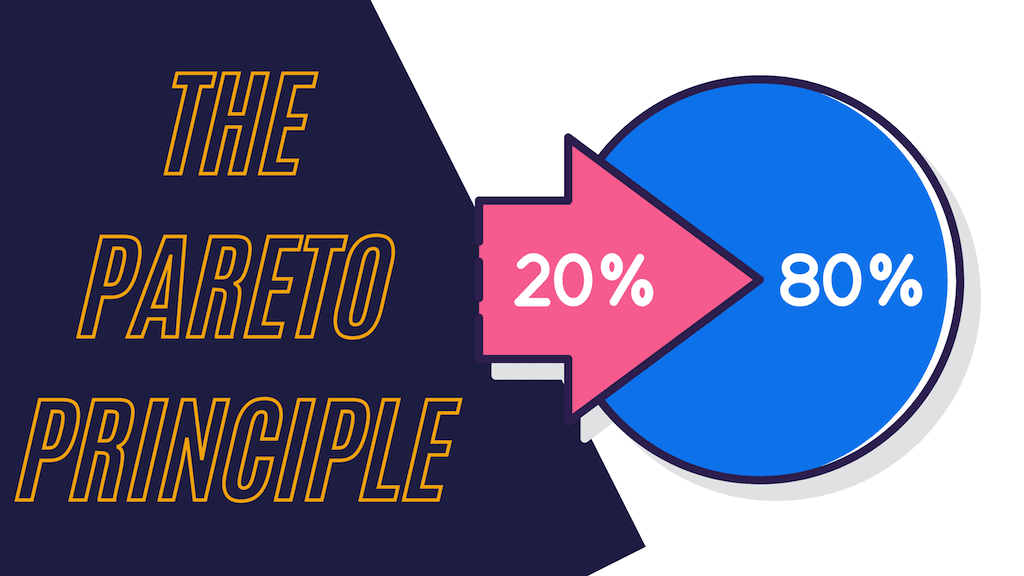Do you ever feel overwhelmed with your workload?
Struggle to manage your time effectively?
Well, the Pareto Principle, also known as the 80/20 rule may hold the key to boosting your productivity and efficiency.
The Pareto Principle is a concept developed by Italian economist Vilfredo Pareto in the early 20th century. The concept states that
“roughly 80% of effects come from 20% of causes”
This simply means that a small number of actions or inputs often account for the majority of the results – and it’s been observed in a wide range of fields, from business to economics to time management.
Time is one of our most valuable resources, and using it effectively is essential for achieving our goals and being successful. But, time management is something that a lot of people struggle with – often spending too much time on low-value tasks and not enough time on high-value ones.
By applying the Pareto Principle to your time management strategies, you can identify and prioritize the most important tasks that will have the greatest impact on your productivity and success.
Understanding the Pareto Principle
To fully appreciate the power of the Pareto Principle in time management, it’s important to first understand its history, basic principles, and application in various fields.
The Pareto Principle is named after Italian economist Vilfredo Pareto, who observed that 80% of the wealth in Italy was owned by just 20% of the population. He later found that this 80/20 ratio applied to other areas like land ownership and crop yields.

At its core, the Pareto Principle suggests that a small number of causes are responsible for the majority of results.
The Pareto Principle has been proven to have an impact in so many fields, from business and economics to healthcare and social sciences.
In business: 20% of customers often account for 80% of revenue
In healthcare: 20% of patients may account for 80% of medical costs
In software development: 20% of bugs may cause 80% of crashes
When it comes to time management, the Pareto Principle can help you identify the tasks that are most important and prioritize them accordingly. By focusing on the vital few tasks that will have the greatest impact on our productivity and success, you can make the most of your limited time and resources.
This can involve identifying the 20% of tasks that generate 80% of results, delegating low-priority tasks to others, and using tools and techniques to maximize efficiency. The Pareto Principle is a powerful tool that can help us work smarter, not harder, and achieve our goals more effectively.
Applying the Pareto Principle to Time Management
Now that you understand the basic principles of the Pareto Principle, let’s look at how you can apply it to your daily life to maximize productivity.
The first step in applying the Pareto Principle in time management is to identify your most important tasks that will have the greatest impact on your goals. These are the tasks referred to as the “vital few.”
If you need a little help setting your goals so that you can identify those important tasks, take a look at our goal-setting series where we cover:
To identify these vital few tasks, you need to ask yourself questions like:
- “What tasks will generate the most revenue?“
- “What tasks are critical to meeting my deadlines?“
- “What tasks will have the greatest impact on my long-term success?“
Once you’ve identified the vital few tasks, we can use the 80/20 rule to start prioritizing them. To do this, you need to focus on the 20% of tasks that will generate 80% of the desired results.
You can do this by listing out your tasks and assigning them a priority level based on their impact and importance. You then focus on completing the high-priority tasks first, before moving on to lower-priority tasks.
And of course, you can also use some other time management tools and techniques in parallel to maximize your efficiency.
Here are some of our favorite time management techniques:
Benefits of Using the Pareto Principle in Time Management
Using the Pareto Principle in time management can have significant benefits to your workflows, productivity, and efficiency. Here’s what we think the most important advantages are:
Increase productivity and efficiency: By identifying the vital few tasks that generate the most results, you can focus your efforts on what matters most and eliminate time-wasting activities.
Reduce stress and overwhelm: When you’re able to prioritize your tasks effectively, you can avoid getting overwhelmed by a to-do list longer than your arm. This can help to reduce stress and anxiety, making you feel more in control of your workload.
Improve work-life balance: By using the Pareto Principle to manage your time more effectively, you can free up more time for the things that matter most outside of work as well. This can lead to improved work-life balance and greater overall satisfaction with your life.
Challenges and Limitations of the Pareto Principle in Time Management
The Pareto Principle is a powerful tool for time management, but like any tool, it has its limitations.
The risk of over-reliance and over-simplification: The Pareto Principle is a valuable concept for time management, but it’s important not to rely on it too heavily. In some cases, it may be more appropriate to focus on other factors, like urgency or importance, when prioritizing tasks.
On your quest for efficiency, you could also be at risk of over-simplifying the principle to the point where it becomes ineffective. For example, not all tasks can be neatly categorized as either high- or low-value. Prioritization is heavily nuanced.
The Pareto Principle and the changing nature of work: The Pareto Principle assumes that the relationship between effort and output is consistent across all tasks. However, this assumption may not hold true in today’s complex work environment, where many tasks require a high level of creativity, collaboration, and critical thinking. In such cases, it may be difficult to determine which tasks are most valuable.
How to Overcome the Limitations of the Pareto Principle

Take a holistic approach.
This means considering factors like urgency, importance, and complexity when prioritizing your tasks – and being willing to adjust priorities when circumstances change, being open to new approaches to time management, and finally, recognizing that time management is an ongoing process that requires continuous learning and improvement.
When you’re your own boss or working on the move, this whole time management thing can be particularly tough. So, go check out our specific guides on
Start Implementing the Pareto Principle Today
The Pareto Principle, also known as the 80/20 rule, is a powerful tool for managing time effectively. By identifying the most important tasks and focusing on them first, you can increase your productivity, reduce stress and achieve a better work-life balance.
By applying the Pareto Principle in time management, you can streamline your work processes and achieve more in less time, leading to a more fulfilling and productive life – which is what we’re all chasing after in some way or another.
The Pareto Principle in Time Management FAQs
The Pareto Principle can be applied to personal time management by identifying the vital few tasks that yield the most significant results and focusing on them.
The Eisenhower Matrix is a time management tool that helps prioritize tasks based on urgency and importance, while the Pareto Principle focuses on identifying the 20% of tasks that yield 80% of the results.
Yes, the Pareto Principle can be applied to complex and creative tasks by identifying the key elements that have the most significant impact on the outcome.
The impact of the Pareto Principle in time management can be measured by tracking productivity and efficiency before and after implementing the principle.
Some common mistakes people make when applying the Pareto Principle to time management include misidentifying the vital few tasks, becoming too rigid in task prioritization, and not adjusting for changing circumstances.




